Biometeorological Conditions During Heat Events in Polish Cities in Summer Months from 2020 to 2024
Abstract
1. Introduction
2. Materials and Methods
2.1. Study Area
2.2. Data and Methods
- tmaxi: the maximum air temperature [°C] on day i
- n: the number of days in a heatwave
- M: metabolic heat production [W∙m−2]
- T: air temperature [°C]
- vp: air vapor pressure [hPa]
3. Results
3.1. Occurrence of Hot Days and Heatwaves
3.2. Biometeorological Conditions During Hot Days and Heatwaves
3.3. Heatwave of June 2021–Case Study
3.4. Biometeorological Conditions During Heatwaves in the City Center and Outside the City
4. Discussion
5. Conclusions
- Between 2020 and 2024, all analyzed Polish cities experienced a rising frequency and intensity of heat stress, particularly during prolonged heatwaves. This trend reflects global patterns of increasing thermal stress;
- Spatial heterogeneity in UTCI values and associated heart rate responses across Polish cities highlights regional differences in bioclimatic vulnerability. The most unfavorable biometeorological conditions, characterized by the frequent occurrence of strong and very strong heat stress, were observed in Southern Poland;
- Several specific thermal stress patterns related to city locations have been identified:
- –
- Residents and visitors in Wrocław may be particularly vulnerable to the severe effects of heat stress, as both daytime UTCI values and daily mean UTCI values were the highest among all analyzed cities during strong heatwaves;
- –
- The highest mean maximum UTCI values during hot days were recorded in Eastern Poland (Białystok and Lublin), influenced by the region’s strong thermal continentality;
- –
- The fewest hot days and heatwave events were observed in Gdańsk, with the lowest maximum UTCI values, due to the mitigating effects of its coastal environment;
- Comparisons between biometeorological conditions in city centers and their outskirts reveal significant differences, with heat stress levels generally higher in city centers. For instance, in Lublin, very strong heat stress was recorded only in the city center. The distribution of UTCI differences between urban and suburban areas, along with their diurnal patterns, confirms the significant influence of the atmospheric urban heat island effect in Polish cities, which further amplifies heat stress on the human body;
- The persistent occurrence of conditions causing significant heat stress on the human body necessitates the integration of biometeorological assessments into urban planning. Such measures are essential for mitigating urban heat stress and enhancing cities’ resilience against climate change impacts;
- Continuous research on urban climate factors, such as air temperature, surface temperature, and biometeorological conditions, remains critical for understanding and addressing extreme heat effects;
- Future studies should incorporate biometeorological assessments, urban morphology, and socio-economic vulnerabilities to develop targeted adaptation strategies. Special attention should be given to green spaces within the urban built-up environment.
Author Contributions
Funding
Institutional Review Board Statement
Informed Consent Statement
Data Availability Statement
Acknowledgments
Conflicts of Interest
References
- Błażejczyk, K.; Twardosz, R.; Wałach, P.; Czarnecka, K.; Błażejczyk, A. Heat Strain and Mortality Effects of Prolonged Central European Heat Wave—An Example of June 2019 in Poland. Int. J. Biometeorol. 2022, 66, 149–161. [Google Scholar] [CrossRef] [PubMed]
- Fiala, D.; Havenith, G.; Bröde, P.; Kampmann, B.; Jendritzky, G. UTCI-Fiala Multi-Node Model of Human Heat Transfer and Temperature Regulation. Int. J. Biometeorol. 2012, 56, 429–441. [Google Scholar] [CrossRef] [PubMed]
- Psikuta, A.; Fiala, D.; Laschewski, G.; Jendritzky, G.; Richards, M.; Błażejczyk, K.; Mekjavič, I.; Rintamäki, H.; de Dear, R.; Havenith, G. Validation of the Fiala Multi-Node Thermophysiological Model for UTCI Application. Int. J. Biometeorol. 2012, 56, 443–460. [Google Scholar] [CrossRef] [PubMed]
- Jendritzky, G.; de Dear, R.; Havenith, G. UTCI-Why Another Thermal Index? Int. J. Biometeorol. 2012, 56, 421–428. [Google Scholar] [CrossRef]
- Błażejczyk, K.; Broede, P.; Fiala, D.; Havenith, G.; Ingvar, H.; Jendritzky, G.; Kampmann, B.; Kunert, A. Principles of the New Universal Thermal Climate Index (Utci) and Its Application. Misc. Geogr. 2010, 14, 91–102. [Google Scholar] [CrossRef]
- Di Napoli, C.; Pappenberger, F.; Cloke, H.L. Assessing Heat-Related Health Risk in Europe via the Universal Thermal Climate Index (UTCI). Int. J. Biometeorol. 2018, 62, 1155–1165. [Google Scholar] [CrossRef]
- Krüger, E.L.; Di Napoli, C. Feasibility of Climate Reanalysis Data as a Proxy for Onsite Weather Measurements in Outdoor Thermal Comfort Surveys. Theor. Appl. Climatol. 2022, 149, 1645–1658. [Google Scholar] [CrossRef]
- Kuchcik, M. Defining Heat Waves—Different Approaches. Geogr. Pol. 2006, 79, 47–63. [Google Scholar]
- Kuchcik, M. Heat Waves in Poland over the Period 1993–2002. Przegląd Geogr. 2006, 78, 397–412. (In Polish) [Google Scholar]
- Krzyżewska, A.; Dyer, J.; Krzyzewska, A.; Dyer, J.; Krzyżewska, A.; Dyer, J. The August 2015 Mega-Heatwave in Poland in the Context of Past Events. Weather 2018, 73, 207–214. [Google Scholar] [CrossRef]
- Krzyżewska, A.; Wereski, S.; Dobek, M. Summer UTCI Variability in Poland in the Twenty-First Century. Int. J. Biometeorol. 2021, 65, 1497–1513. [Google Scholar] [CrossRef] [PubMed]
- Wibig, J.; Podstawczyńska, A.; Rzepa, M.; Piotrowski, P. Heatwaves in Poland—Frequency, Trends and Relationships with Atmospheric Circulation. Geogr. Pol. 2009, 82, 47–59. [Google Scholar] [CrossRef]
- Tomczyk, A.M.; Bednorz, E.; Półrolniczak, M.; Kolendowicz, L. Strong Heat and Cold Waves in Poland in Relation with the Large-Scale Atmospheric Circulation. Theor. Appl. Climatol. 2019, 137, 1909–1923. [Google Scholar] [CrossRef]
- Tomczyk, A.M.; Owczarek, M. Occurrence of Strong and Very Strong Heat Stress in Poland and Its Circulation Conditions. Theor. Appl. Climatol. 2020, 139, 893–905. [Google Scholar] [CrossRef]
- Okoniewska, M. Specificity of Meteorological and Biometeorological Conditions in Central Europe in Centre of Urban Areas in June 2019 (Bydgoszcz, Poland). Atmosphere 2021, 12, 1002. [Google Scholar] [CrossRef]
- Rozbicka, K.; Rozbicki, T. Long-Term Variability of Bioclimatic Conditions and Tourism Potential for Warsaw Agglomeration (Poland). Int. J. Biometeorol. 2021, 65, 1485–1495. [Google Scholar] [CrossRef]
- Kuchcik, M.; Czarnecka, K.; Błażejczyk, K. Urban Heat Island in Warsaw (Poland): Current Development and Projections for 2050. Urban Clim. 2024, 55, 101901. [Google Scholar] [CrossRef]
- Półrolniczak, M.; Kolendowicz, L.; Majkowska, A.; Czernecki, B. The Influence of Atmospheric Circulation on the Intensity of Urban Heat Island and Urban Cold Island in Poznań, Poland. Theor. Appl. Climatol. 2017, 127, 611–625. [Google Scholar] [CrossRef]
- Kosmatka, J. Wpływ Miejskiej Wyspy Ciepła Na Parametry Temperatury. Zesz. Nauk. Politech. Poznańskiej 2023, 13, 79–100. [Google Scholar] [CrossRef]
- Bokwa, A.; Dobrovolný, P.; Gál, T.; Geletič, J.; Gulyás, Á.; Hajto, M.J.; Holec, J.; Hollósi, B.; Kielar, R.; Lehnert, M.; et al. Urban Climate in Central European Cities and Global Climate Change. Acta Climatol. Chorol. 2018, 51–52, 7–35. [Google Scholar] [CrossRef]
- Bobrowska-Korzeniowska, M.; Jerzyńska, J.; Paciorek, M.; Stelmach, W. Analysis of the Urban Heat Island in Łódź, Poland. Int. J. Occup. Med. Environ. Health 2024, 37, 581–590. [Google Scholar] [CrossRef] [PubMed]
- Sachindra, D.A.; Ullah, S.; Zaborski, P.; Nowosad, M.; Dobek, M. Temperature and Urban Heat Island Effect in Lublin City in Poland under Changing Climate. Theor. Appl. Climatol. 2023, 151, 667–690. [Google Scholar] [CrossRef]
- Santamouris, M.; Kolokotsa, D. On the Impact of Urban Overheating and Extreme Climatic Conditions on Housing, Energy, Comfort and Environmental Quality of Vulnerable Population in Europe. Energy Build. 2015, 98, 125–133. [Google Scholar] [CrossRef]
- Statistics Poland. Demographic Yearbook of Poland; Rozkrut, D., Ed.; Zakłady Wydawnictw Statystycznych: Warsaw, Poland, 2024. [Google Scholar]
- WMO. Manual on the WMO Integrated Global Observing System. Annex VIII to the WMO Technical Regulations; WMO: Geneva, Switzerland, 2024; Volume WMO-No. 11, ISBN 978-92-63-11160-9. [Google Scholar]
- IMGW Institute of Meteorology and Water Management. Available online: www.imgw.pl (accessed on 11 April 2025).
- Czernecki, B.; Glogowski, A.; Nowosad, J. Climate: An R Package to Access Free in-Situ Meteorological and Hydrological Datasets for Environmental Assessment. Sustainability 2020, 12, 394. [Google Scholar] [CrossRef]
- Crespi, A.; Terzi, S.; Cocuccioni, S.; Zebisch, M.; Julie, B.; Füssel, H.-M. Climate-Related Hazard Indices for Europe; ETC/CCA: Bologna, Italy, 2020. [Google Scholar]
- Wibig, J. Heat Waves in Poland in the Period 1951–2015: Trends, Patterns and Driving Factors. Meteorol. Hydrol. Water Manag. 2017, 6, 1–10. [Google Scholar] [CrossRef]
- Błażejczyk, K.; Błażejczyk, M. Bioklima. 2010. Available online: https://www.igipz.pan.pl/BioKlima.html (accessed on 1 April 2025).
- Bröde, P.; Fiala, D.; Blazejczyk, K.; Holmér, I.; Jendritzky, G.; Kampmann, B.; Tinz, B.; Havenith, G. Deriving the Operational Procedure for the Universal Thermal Climate Index (UTCI). Int. J. Biometeorol. 2012, 56, 481–494. [Google Scholar] [CrossRef]
- Błażejczyk, K.; Kunert, A. Bioclimatic Conditions of Recreation and Tourism in Poland; IGiPZ PAN: Warszawa, Poland, 2011. [Google Scholar]
- American Heart Association. All About Heart Rate. Available online: https://www.heart.org/en/health-topics/high-blood-pressure/the-facts-about-high-blood-pressure/all-about-heart-rate-pulse (accessed on 30 March 2025).
- IMGW-PIB. Climate of Poland 2020; IMGW-PIB: Warsaw, Poland, 2021. [Google Scholar]
- Wibig, J. Hot Days and Heat Waves in Poland in the Period 1951-2019 and the Circulation Factors Favoring the Most Extreme of Them. Atmosphere 2021, 12, 340. [Google Scholar] [CrossRef]
- Ustrnul, Z.; Wypych, A.; Czekierda, D. Air Temperature Change. In Climate Change in Poland: Past, Present, Future; Falarz, M., Ed.; Springer: Berlin/Heidelberg, Germany, 2021; pp. 275–330. [Google Scholar]
- Tomczyk, A.M.; Bednorz, E. Thermal Stress during Heat Waves and Cold Spells in Poland. Weather Clim. Extrem. 2023, 42, 100612. [Google Scholar] [CrossRef]
- Kuchcik, M.; Błażejczyk, K.; Halaś, A. Changes in Bioclimatic Indices. In Climate Change in Poland; Falarz, M., Ed.; Springer Climate: Cham, Switzerland, 2021; pp. 471–491. [Google Scholar]
- Kuchcik, M. Mortality and Thermal Environment (UTCI) in Poland—Long-Term, Multi-City Study. Int. J. Biometeorol. 2021, 65, 1529–1541. [Google Scholar] [CrossRef]
- Wedler, M.; Pinto, J.G.; Hochman, A. More Frequent, Persistent, and Deadly Heat Waves in the 21st Century over the Eastern Mediterranean. Sci. Total Environ. 2023, 870, 161883. [Google Scholar] [CrossRef]
- Falasca, S.; Di Bernardino, A.; Salata, F. On the Identification and Characterization of Outdoor Thermo-Hygrometric Stress Events. Urban Clim. 2023, 52, 101728. [Google Scholar] [CrossRef]
- Dobek, M.; Wereski, S.; Krzyżewska, A. Bioclimatic Conditions of Lublin Based on the Universal Thermal Climate Index (UTCI). Misc. Geogr. 2020, 24, 118–125. [Google Scholar] [CrossRef]
- Lindner-Cendrowska, K. Assessment of Bioclimatic Conditions in Cities for Tourism and Recreational Purposes (a Warsaw Case Study). Geogr. Pol. 2013, 86, 55–66. [Google Scholar] [CrossRef]
- Błażejczyk, K.; Kuchcik, M.; Milewski, P.; Dudek, W.; Kręcisz, B.; Błażejczyk, A.; Szmyd, J.; Degórska, B.; Pałczyński, C. Urban Heat Island in Warsaw: Climate and Urban Conditions; IGiPZ PAN, Ed.; SEDNO Academic Press: Warsaw, Poland, 2014; e-book; ISBN 978-83-7963-019-6. (In Polish) [Google Scholar]
- Fröhlich, D.; Matzarakis, A. Calculating Human Thermal Comfort and Thermal Stress in the PALM Model System 6.0. Geosci. Model Dev. 2020, 13, 3055–3065. [Google Scholar] [CrossRef]

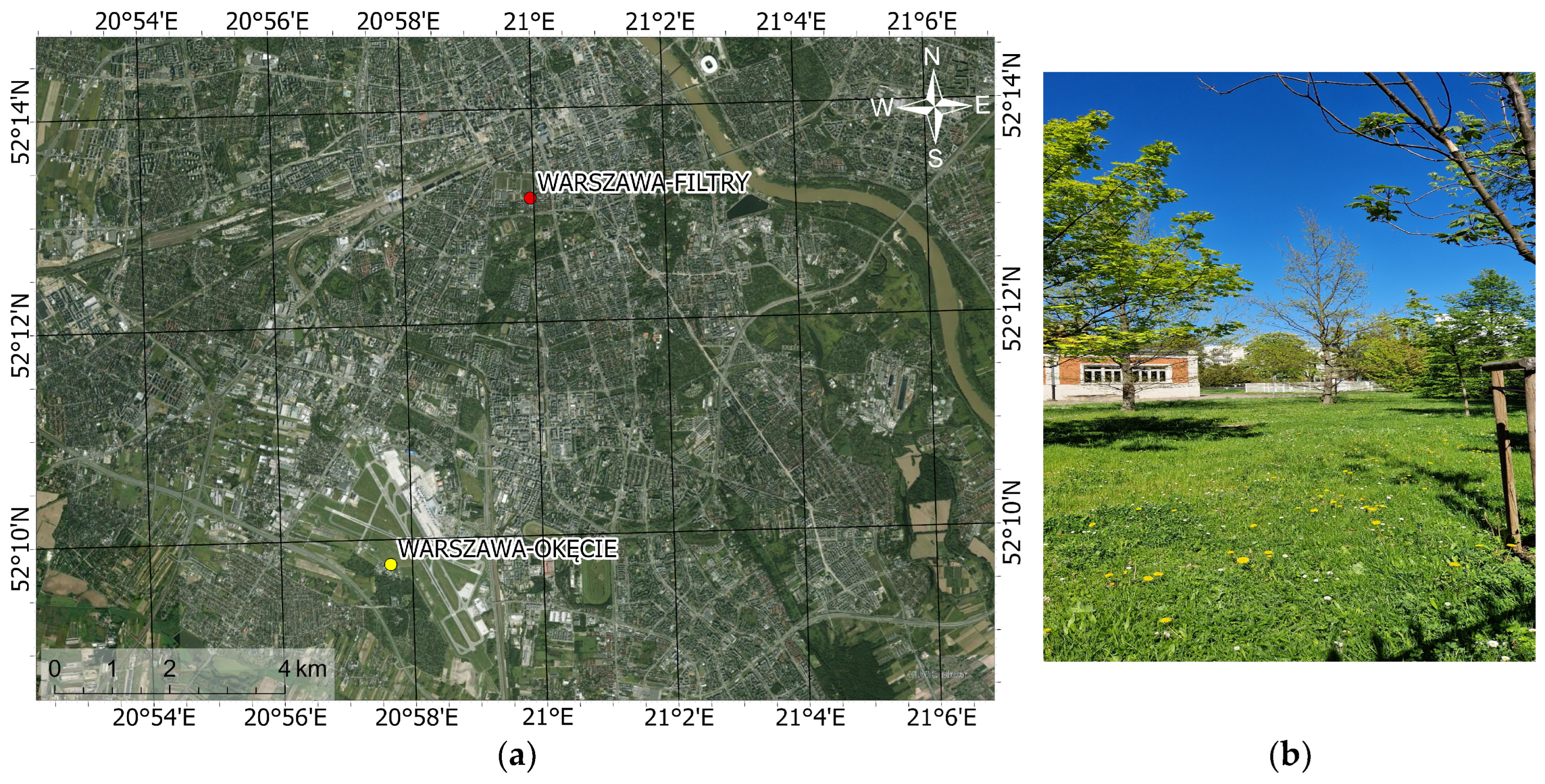
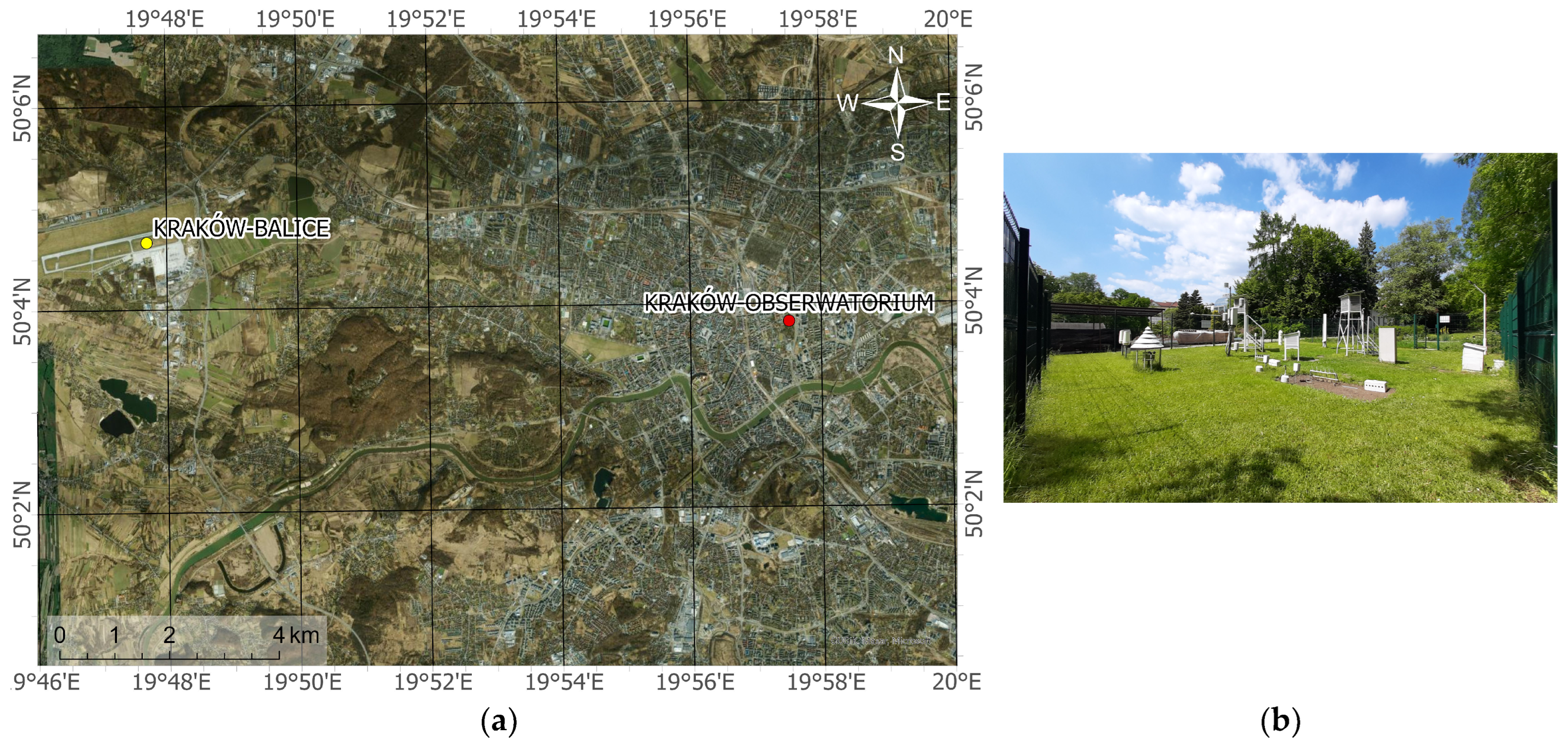
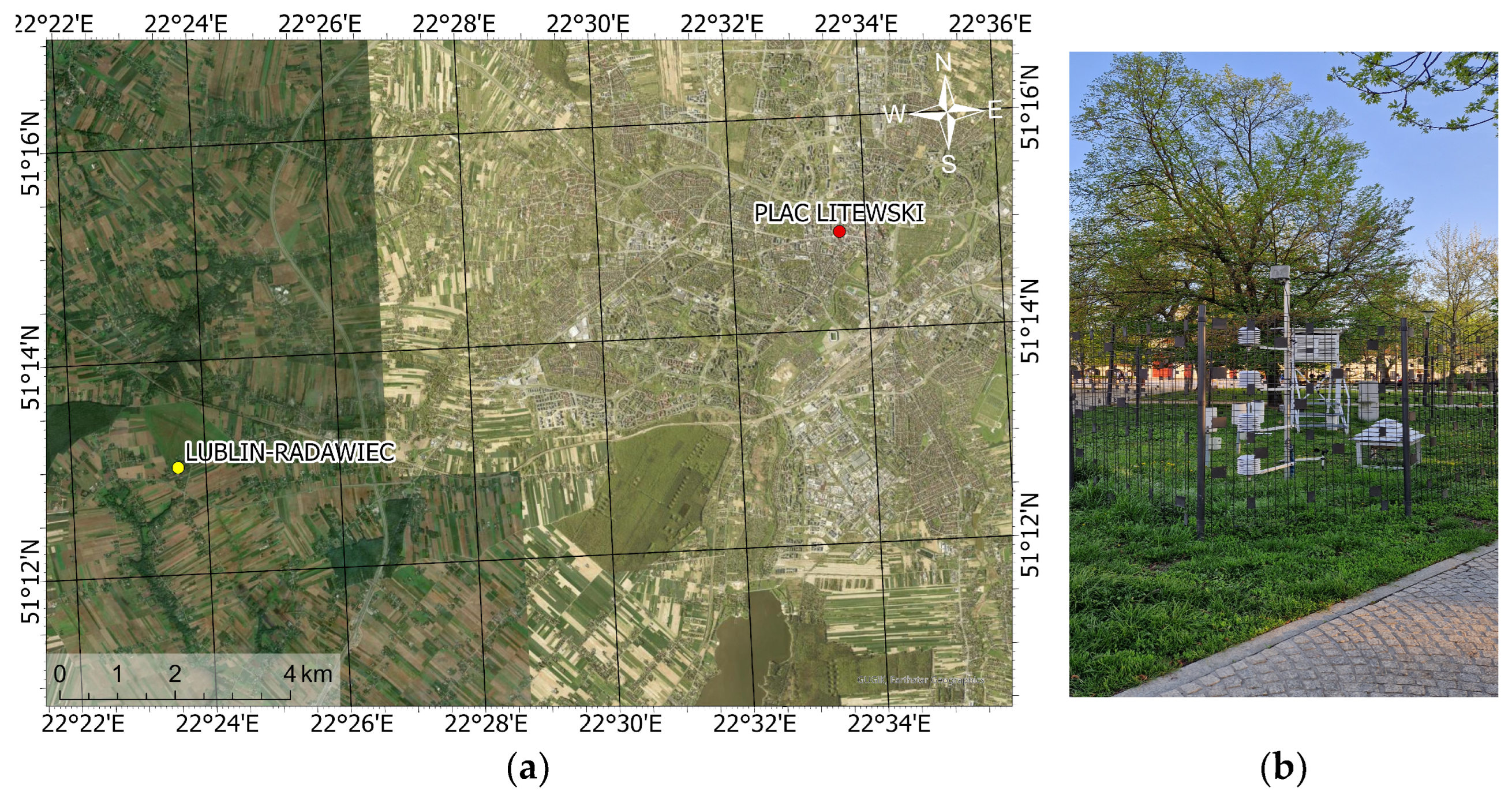
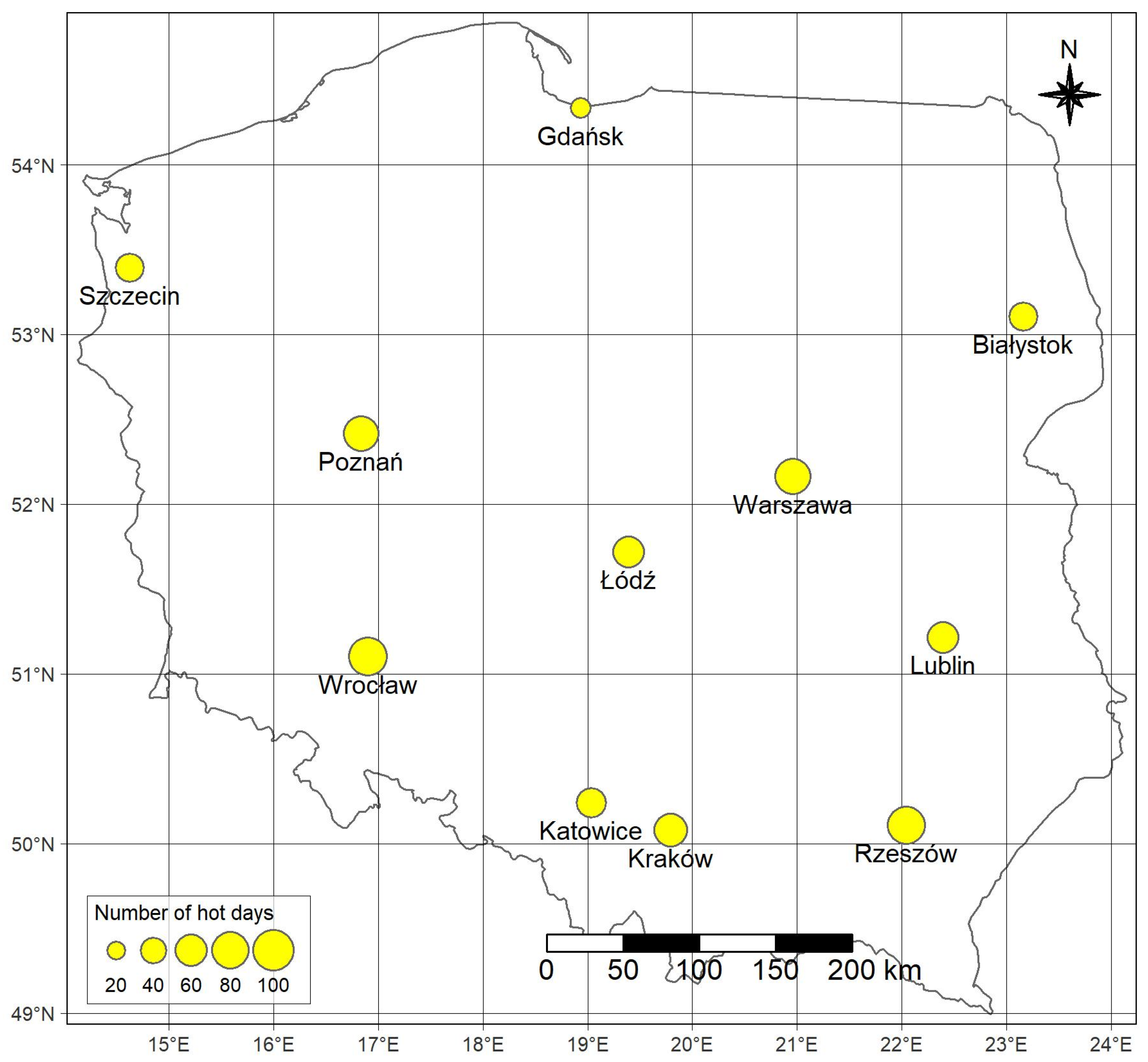
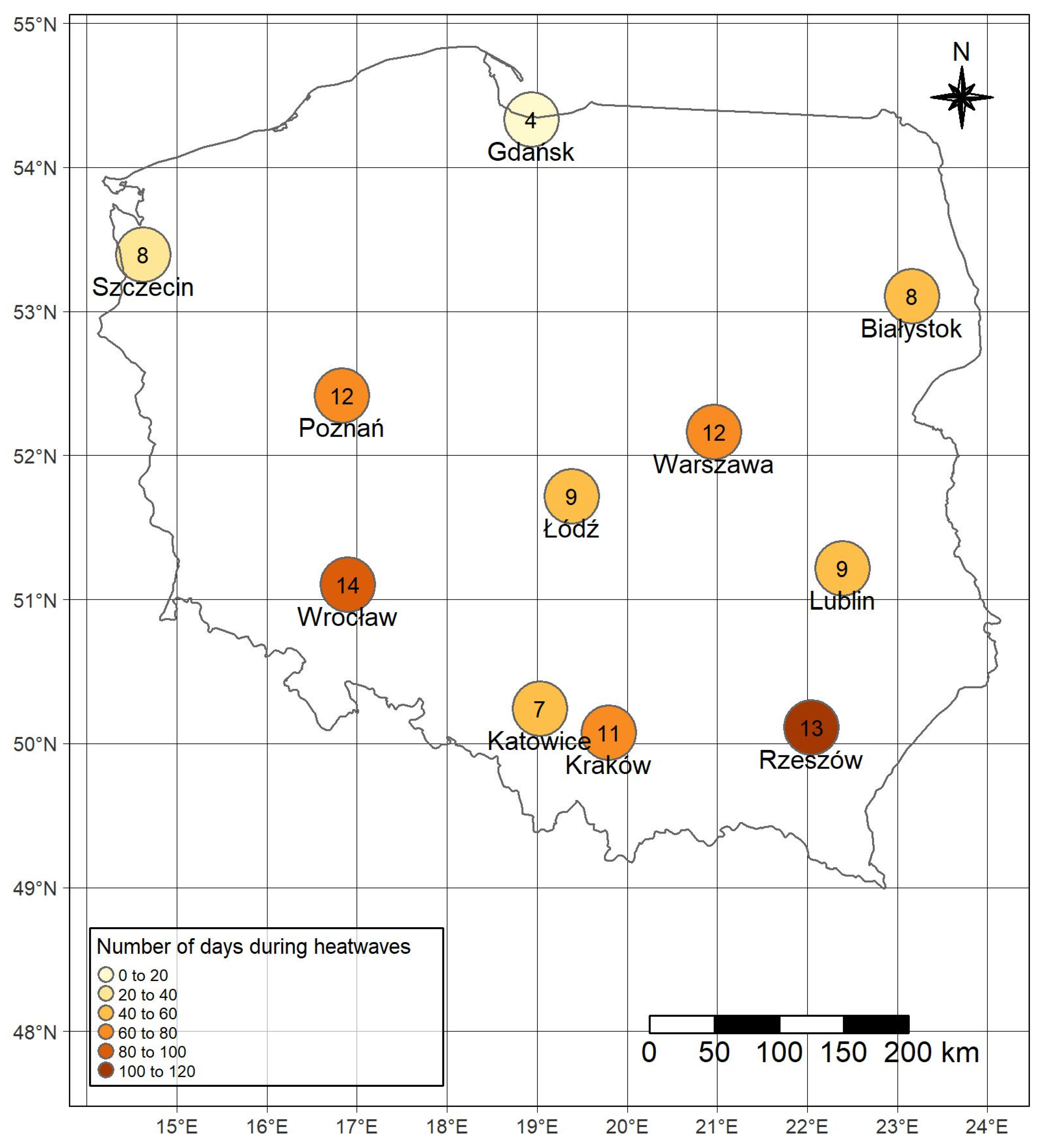
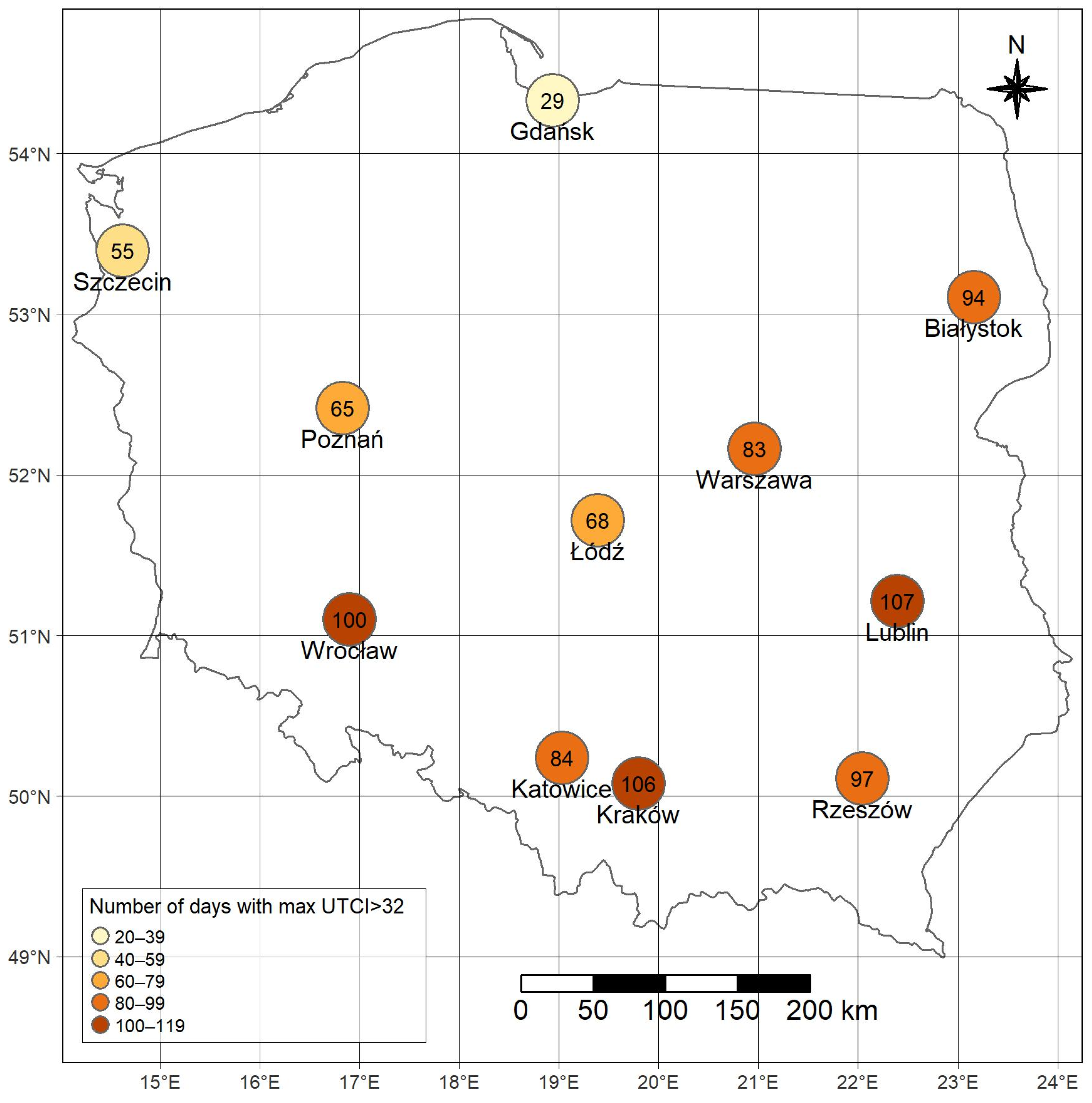
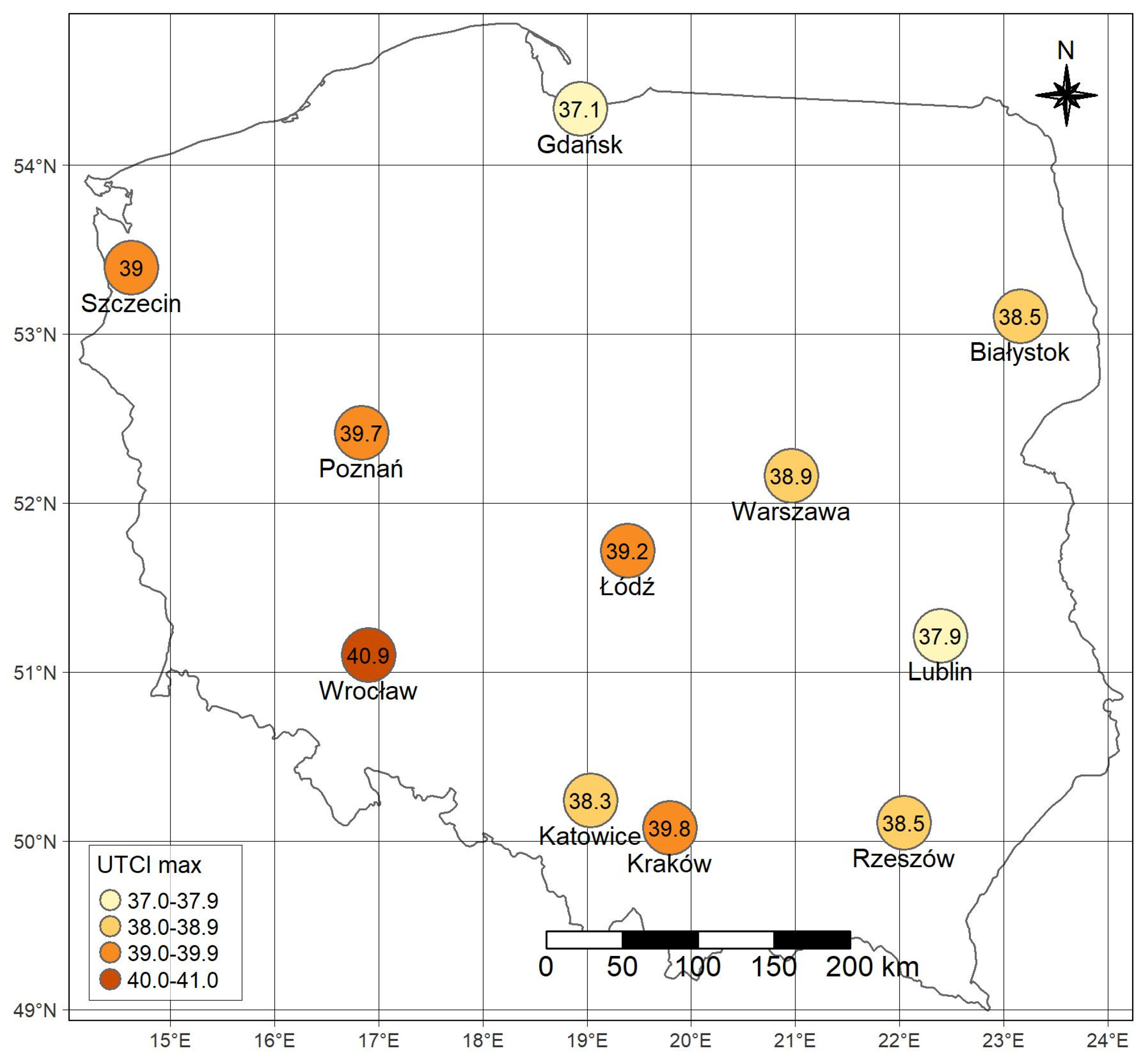


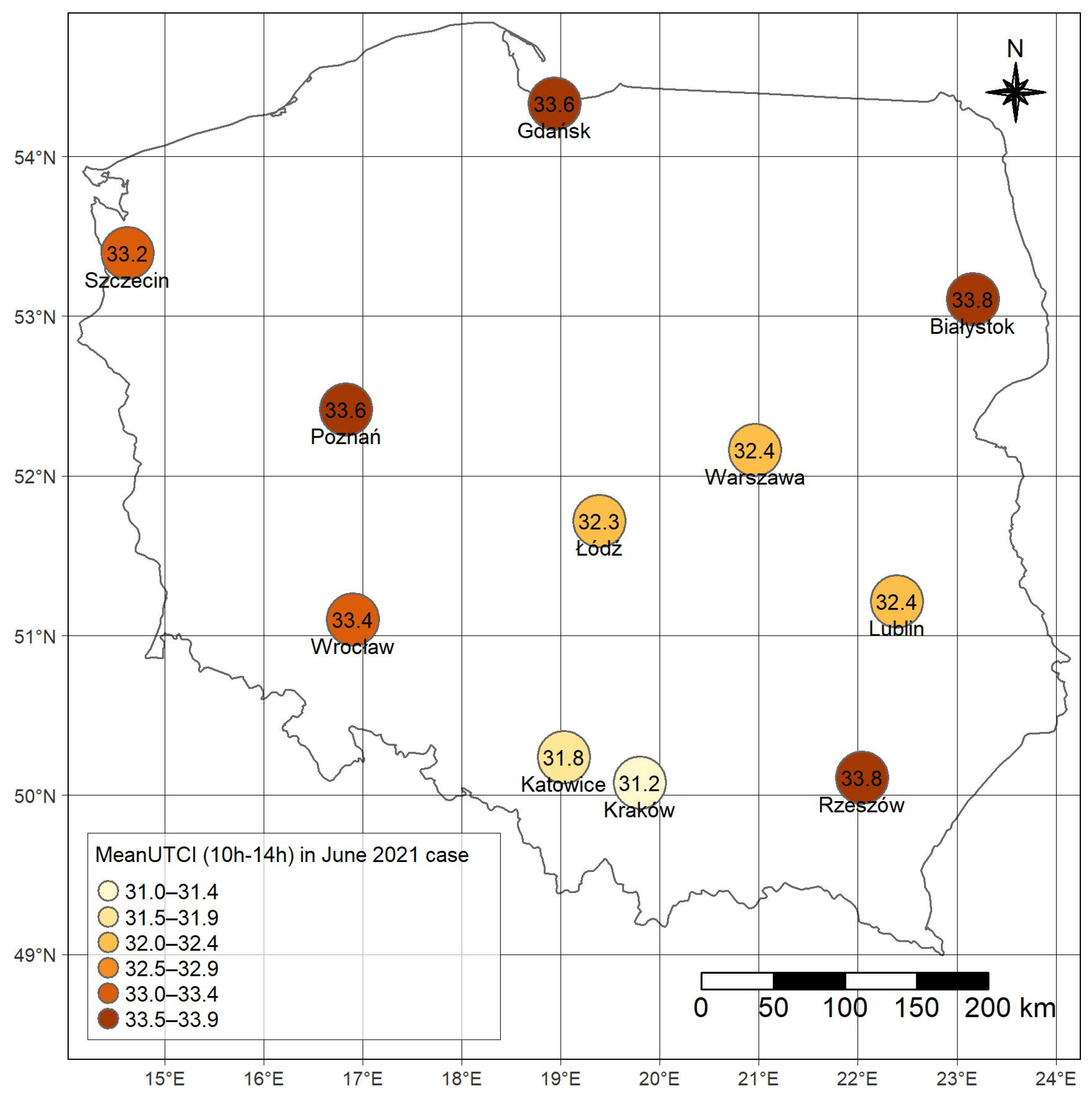
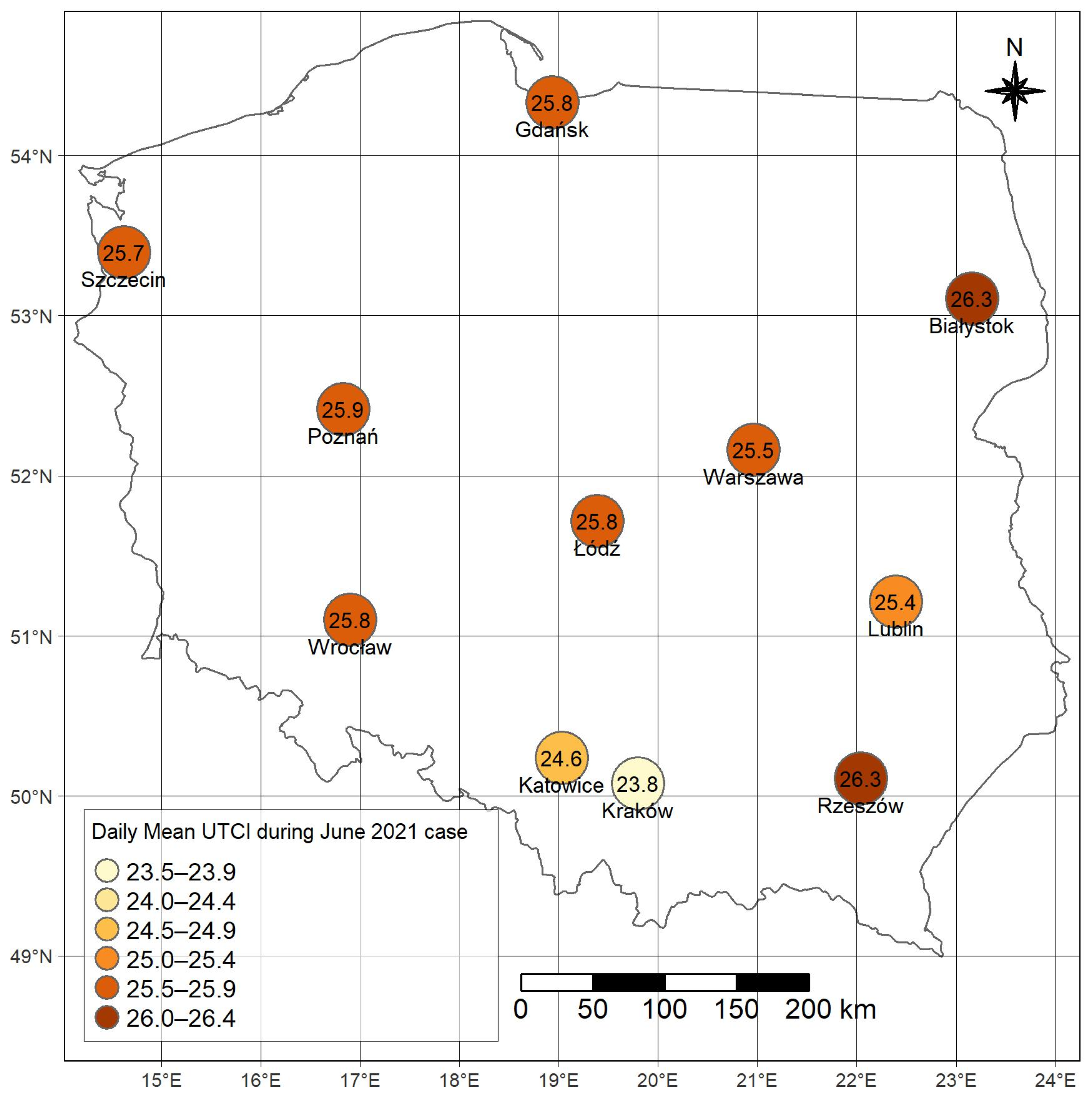
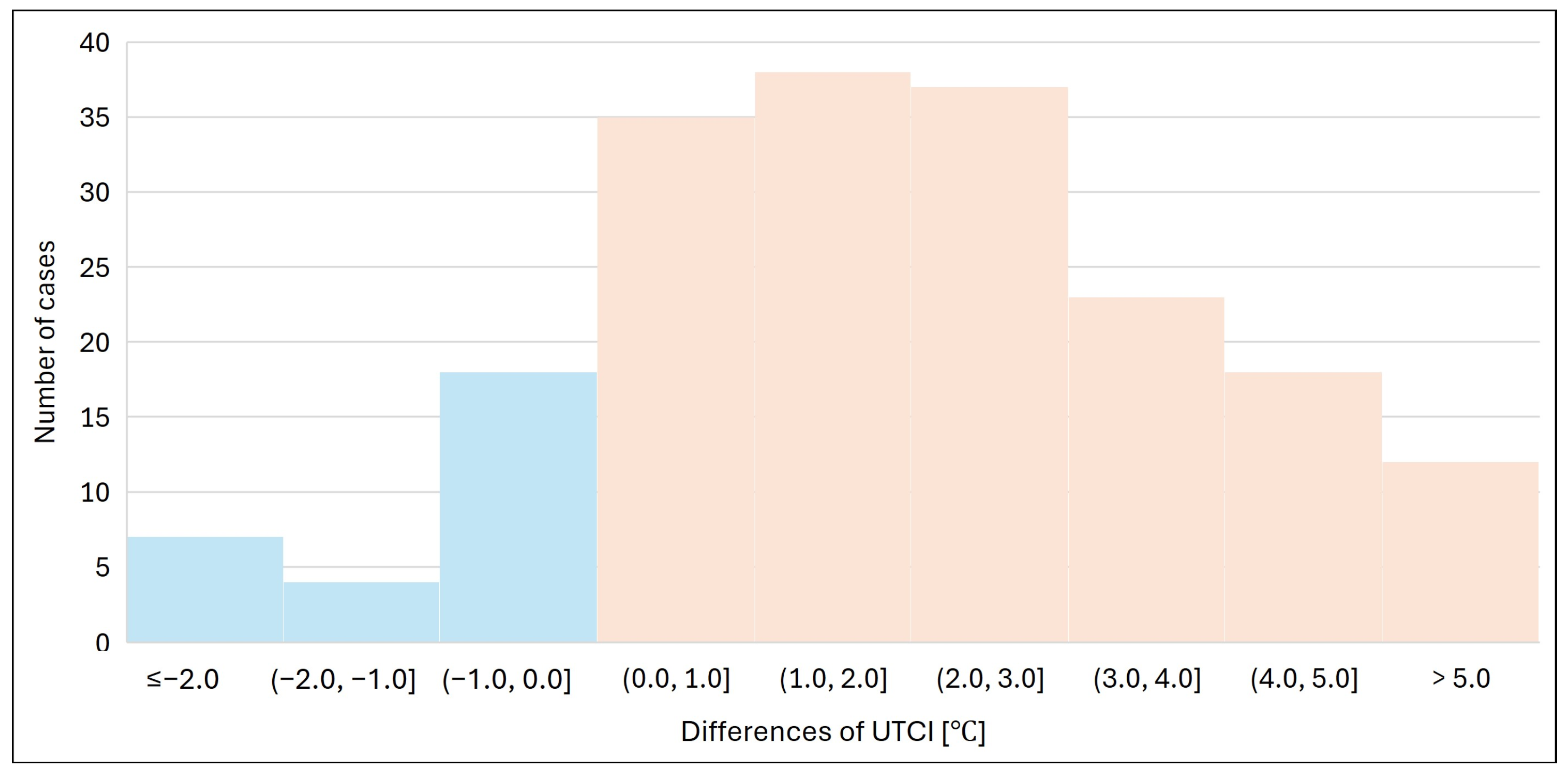

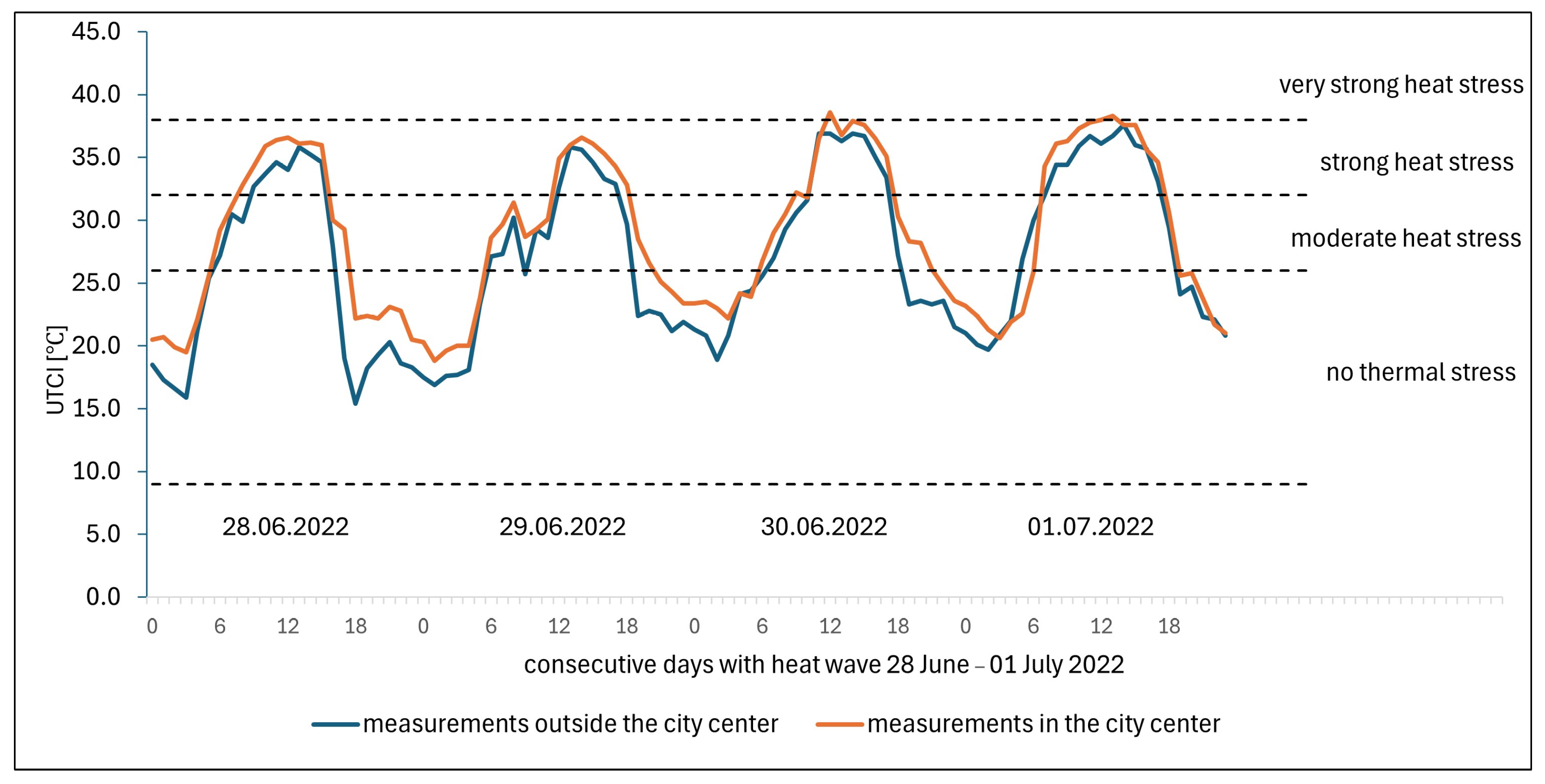
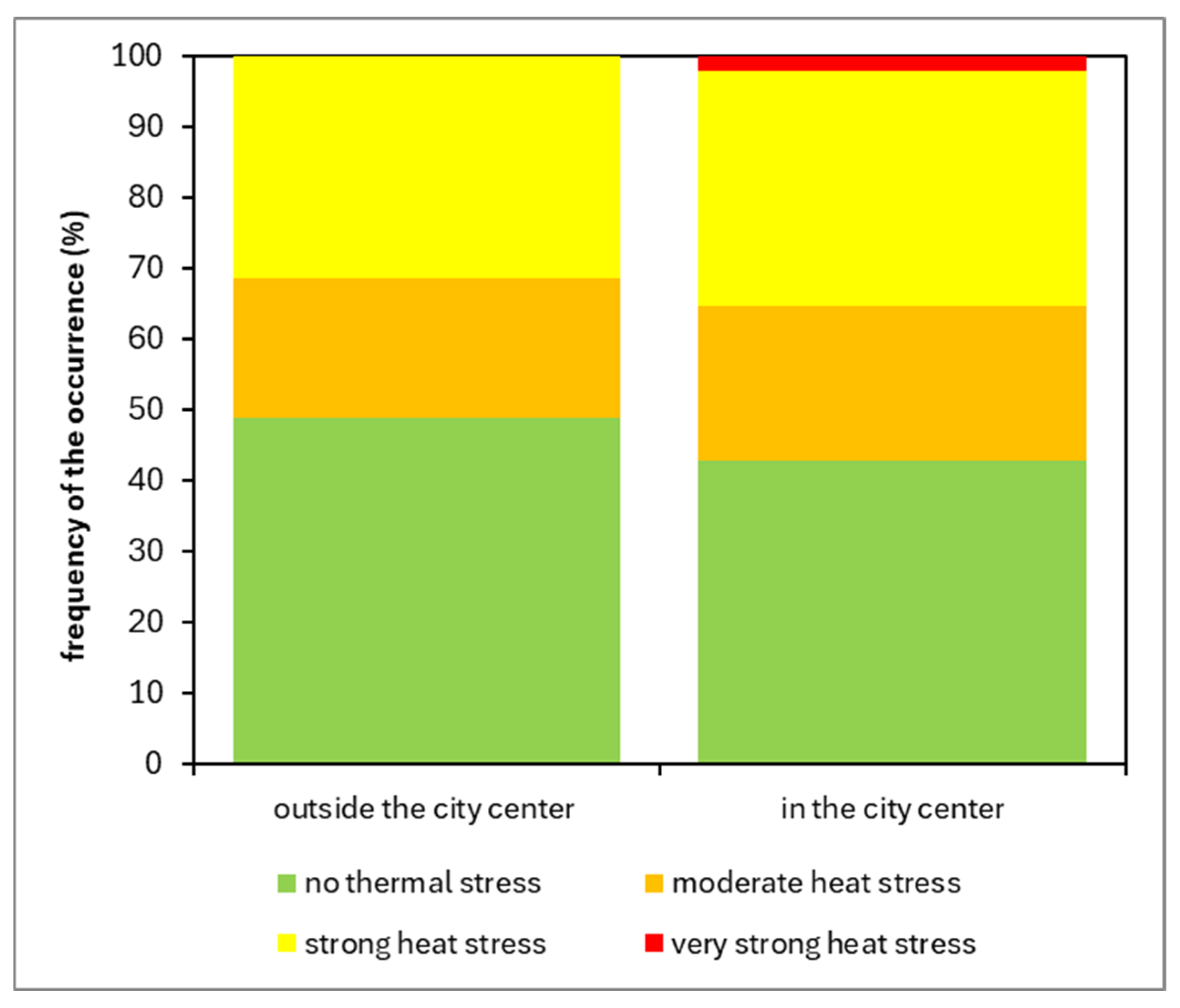
| City | Longitude | Latitude | Population 1 |
|---|---|---|---|
| Warszawa | 20.96 | 52.16 | 1,861,599 |
| Kraków | 19.79 | 50.08 | 806,201 |
| Wrocław | 16.90 | 51.10 | 673,743 |
| Łódź | 19.39 | 51.72 | 652,015 |
| Poznań | 16.83 | 52.42 | 538,439 |
| Gdańsk | 18.93 | 54.33 | 487,371 |
| Szczecin | 14.62 | 53.40 | 389,066 |
| Lublin | 22.39 | 51.22 | 329,565 |
| Białystok | 23.16 | 53.11 | 291,688 |
| Katowice | 19.03 | 50.24 | 279,190 |
| Rzeszów | 22.04 | 50.11 | 197,268 |
| UTCI Range [°C] | Stress Category |
|---|---|
| >46.0 | extreme heat stress |
| 38.1 to 46.0 | very strong heat stress |
| 32.1 to 38.0 | strong heat stress |
| 26.1 to 32.0 | moderate heat stress |
| 9.1 to 26.0 | no thermal stress |
| 0.1 to 9.0 | slight cold stress |
| −12.9 to 0.0 | moderate cold stress |
| −26.9 to −13.0 | strong cold stress |
| −39.9 to −27.0 | very strong cold stress |
| ≤−40.0 | extreme cold stress |
| Heatwave | The Start 1 | The End 1 | Duration Range (Days) |
|---|---|---|---|
| June 2021 | 18 June 2021 | 24 June 2021 | 3–7 |
| June 2022 | 27 June 2022 | 1 July 2022 | 4–8 |
| July 2022 | 19 July 2022 | 22 July 2022 | 3–4 |
| August 2023 | 14 August 2023 | 20 August 2023 | 3–8 |
| August 2024 | 15 August 2024 | 18 August 2024 | 3–4 |
| City | HWS Max | Date (dd/mm/yy) | Biometeorological Conditions During the Most Intense Heatwave at a Given Station | |||||
|---|---|---|---|---|---|---|---|---|
| UTCI Max [°C] | UTCI Daily Average [°C] | UTCI Average Between the Hours of 10–14 UTC [°C] | Occurrence of “Strong and Very Strong Heat Stress” [%] | Heart Rate Max [bpm] | Heart Rate Daily Average [bpm] | |||
| Warszawa | 17.2 | 26 June 2022 – 2 July 2022 | 38.9 | 24.7 | 29.6 | 17.4 | 103 | 91 |
| Kraków | 14.1 | 15 August 2023 – 20 August 2023 | 39.8 | 26.1 | 33.6 | 29.9 | 102 | 90 |
| Wrocław | 21.0 | 19 July 2022 – 22 July 2022 | 40.9 | 27.6 | 36.4 | 40.6 | 102 | 90 |
| Łódź | 11.1 | 19 July 2022 – 23 July 2022 | 37.9 | 25.0 | 34.5 | 29.5 | 97 | 86 |
| Poznań | 14.8 | 17 June 2021 – 21 June 2021 | 37.3 | 25.9 | 33.6 | 23.3 | 99 | 91 |
| Gdańsk | 6.0 | 19 June 2021 – 21 June 2021 | 35.1 | 25.8 | 33.6 | 26.4 | 99 | 92 |
| Szczecin | 15.2 | 17 June 2021 – 21 June 2021 | 38.3 | 25.7 | 33.2 | 27.5 | 104 | 92 |
| Lublin | 9.7 | 28 June 2022 – 1 July 2022 | 37.6 | 26.9 | 34.8 | 31.3 | 102 | 92 |
| Białystok | 9.9 | 15 August 2023 – 20 August 2023 | 38.2 | 26.3 | 34.2 | 52.8 | 100 | 90 |
| Katowice | 9.4 | 20 July 2022 – 23 July 2022 | 36.8 | 25.6 | 33.8 | 29.2 | 98 | 88 |
| Rzeszów | 16.6 | 27 June 2022 – 1 July 2022 | 37.6 | 26.2 | 34.8 | 28.3 | 103 | 92 |
| City | The Start | The End | The Length |
|---|---|---|---|
| Kraków | 18 June 2021 | 21 June 2021 | 7 |
| Lublin | 22 June 20.21 | 24 June 2021 | 3 |
| Łódź | 18 June 2021 | 22 June 2021 | 5 |
| Poznań | 17 June 2021 | 21 June 2021 | 5 |
| Rzeszów | 22 June 2021 | 24 June 2021 | 3 |
| Warszawa | 18 June 2021 | 22 June 2021 | 5 |
| Wrocław | 17 June 2021 | 21 June 2021 | 5 |
| Gdańsk | 19 June 2021 | 21 June 2021 | 3 |
| Katowice | 19 June 2021 | 24 June 2021 | 6 |
| Szczecin | 17 June 2021 | 21 June 2021 | 5 |
| Białystok | 19 June 2021 | 23 June 2021 | 5 |
Disclaimer/Publisher’s Note: The statements, opinions and data contained in all publications are solely those of the individual author(s) and contributor(s) and not of MDPI and/or the editor(s). MDPI and/or the editor(s) disclaim responsibility for any injury to people or property resulting from any ideas, methods, instructions or products referred to in the content. |
© 2025 by the authors. Licensee MDPI, Basel, Switzerland. This article is an open access article distributed under the terms and conditions of the Creative Commons Attribution (CC BY) license (https://creativecommons.org/licenses/by/4.0/).
Share and Cite
Owczarek, M.; Krzyżewska, A. Biometeorological Conditions During Heat Events in Polish Cities in Summer Months from 2020 to 2024. Atmosphere 2025, 16, 645. https://doi.org/10.3390/atmos16060645
Owczarek M, Krzyżewska A. Biometeorological Conditions During Heat Events in Polish Cities in Summer Months from 2020 to 2024. Atmosphere. 2025; 16(6):645. https://doi.org/10.3390/atmos16060645
Chicago/Turabian StyleOwczarek, Małgorzata, and Agnieszka Krzyżewska. 2025. "Biometeorological Conditions During Heat Events in Polish Cities in Summer Months from 2020 to 2024" Atmosphere 16, no. 6: 645. https://doi.org/10.3390/atmos16060645
APA StyleOwczarek, M., & Krzyżewska, A. (2025). Biometeorological Conditions During Heat Events in Polish Cities in Summer Months from 2020 to 2024. Atmosphere, 16(6), 645. https://doi.org/10.3390/atmos16060645








